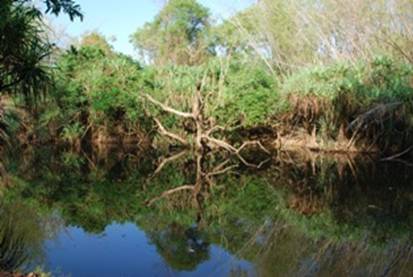Kakadu National Park, New Territories, Australia

|
We had two days to “do” Kakadu. This was an
impossible task, given that it is the second largest National Park in One thing our guide Leah was quick to point out was that
whilst the German for Cockatoo is “Kakadu”…that is not why it
s called Kakadu. Yes,….there are loads of these beautiful white birds
with their trade mark head feathers and nut cracking beak. But, it is, we
were told, a complete coincidence. The real reason was because the first
white people to come here misheard the pronunciation by the Aboriginal tribe, (now
extinct), that occupied the area. Aborigines have lived here for tens of thousands of years,
but it is only in the relatively recent past that the Australian Government has
come to recognise the rights of the indigenous people and so has given back
much of Kakadu to the care and control of the Aboriginal people. Some 500 live
here full time. The park itself has 70 full time ranges, 28 of whom are Aboriginal.
In aboriginal culture the individual owns nothing. All land and possessions
are owned by them all. Whilst they do now live in houses, drive cars and watch
TV. They still have a strong culture, customs and ways of doing things…..quite
different to the white man. The only part of Kakadu that they do not own is the
Uranium deposits. That funnily enough is controlled by the Australian government.
There is active mining within the park, and the town of Some of the wild life in the park is not native. For example
the wild horses. There are estimated to be 20,000 of them. They originally came
from the white mans farms on the land. When the farms closed down, the horses were
turned loose. They have gone on to be so successful in the wild that there now
has to be an annual cull.
Asian Buffalo were also brought in. This was primarily for
their skins, which are very thick. 2 or 3 inches apparently, and incredibly
strong. There skins were used for making all manner of belts, especially
for the mining industry, The belts used in conveyor belts were made from their
skins. These too (the Some of the scenery is very picturesque in an “outback”
style………..
We spent a chunk of time hiking around
The colour of the light on the rocks combined with the water
made for some interesting photo opportunities. In fact I took several hundred
pictures doing our visit to the
After our visit to the Nourlangie Rock area, which is just
spell binding with its 2,500 million year old sand stone escarpment. It was
time to visit the site of the Aboriginal Cave Art. The locals used to take refuge
in these caves during the wet season, to protect them from cyclones and the generally
dreadful weather that this area of Australia enjoys for around 4 months
of the year, December thru’ March. So to pass the time the natives, that
is exclusively the men, depicted folk lore with rock art. These are very famous
and relate to important structures and rules for the aboriginal society.
Some of these drawings and paintings are estimated to be over 20,000 years old.
This was the high light of the trip for me. Essentially, each picture cum
drawing spells out a moral code for the young people in the tribe to learn
from.
One of the lighter moments of the tour happened during one of
our swimming breaks at Maguk waterfall and plunge pool. Several of us were just
chatting away after a nice swim, when this frog came leaping through the middle
of our group….at a frenetic pace. We soon discovered why………….A
yellow tree snake was after his lunch! Leah grabbed it by the tail and then
gently ran her other hand down the full length of his body, from tail to head.
This calmed the snake down (but not Jennie). WE then had the opportunity to
have a close look at this colourful and none poisonous snake. Before it
was returned to the wild…away from the frog!
Our final stop before lunch on the last day and our return
to
This one pictured above is 7.5 metres high and is at least
75 years old. ( The mound that is…….) The species of termite that
inhabit these amazing structures tunnel beneath the ground into the nearby
pasture land and then cut of chunks of grass and cart them back to the mound. These
are then converted in to Cellulose and digested by the termites,. What you see
in the picture above is, not to put too finer point on it. A heap of termite
shit. But it is waterproof, fire proof and most of the time Soldier Ant
proof. The soldier ant being the Termites deadliest enemy. If they gain access
to the mound, then all the termites are eaten by the ants, There is a second species
in this park. These occupy the trees. It is said some 75% of all the tress in
Kakadu are hollow, due to the efforts of these industrious creatures. After our return to The journey to Kupang was a rather tedious three day affair.
No wind at all so we motored the whole way in stifling heat and humidity. The
arrival in |






